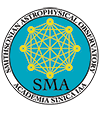 |
|
|
|
Circumstellar Disk Studies with the SMA
| ||||||||
|
Orion Proplyds
S. M. Andrews, J. P. Williams, High Resolution Submillimeter Constraints on Circumstellar Disk Structure, 2007, ApJ, 659, 705
S. M. Andrews, D. J. Wilner, A. M. Hughes, C. Qi, C. P. Dullemond, Protoplanetary Disk Structures in Ophiuchus, 2009, ApJ, 700, 1502
A. M. Hughes, D. J. Wilner, I. Kamp, M. R. Hogerheijde, A Resolved Molecular Gas Disk around the Nearby A Star 49 Ceti, 2008, ApJ, 681, 626
A. M. Hughes, D. J. Wilner, J. Cho, D. P. Marrone, A. Lazarian, S. M. Andrews, R. Rao, Stringent Limits on the Polarized Submillimeter Emission from Protoplanetary Disks, 2009, ApJ, 704, 1204
R. K. Mann, J. P. Williams, The Circumstellar Disk Mass Distribution in the Orion Trapezium Cluster, 2009, ApJ, 694, L36
R. K. Mann, J. P. Williams, Massive Protoplanetary Disks in Orion Beyond the Trapezium Cluster, 2009, ApJ, 699, L55
K. I. Oberg, C. Qi, J.K.J. Fogel, E. A. Bergin, S. M. Andrews, C. Espaillat, T. A. van Kempen, D. J. Wilner, Disk Imaging Survey of Chemistry with SMA (DISCS): I. Taurus Protoplanetary Disk Data, 2010, accepted to ApJ
O. Panic, M. R. Hogerheijde, D. Wilner, C. Qi, A break in the gas and dust surface density of the disc around the T Tauri star IM Lup, 2009, A&A, 501, 269
C. Qi, P. T. P. Ho, D. J. Wilner, S. Takakuwa, N. Hirano, N. Ohashi, T. L. Bourke, Q. Zhang, G. A. Blake, M. Hogerheijde, M. Saito, M. Choi, and J. Yang, Imaging the Disk around TW Hydrae with the Submillimeter Array, 2004, ApJ, 616, L11
C. Qi, D. J. Wilner, N. Calvet, T. L. Bourke, G. A. Blake, M. R. Hogerheijde, P. T. P. Ho, and E. Bergin, CO J=6--5 Observations of TW Hya with the SMA, 2006, ApJ, 636, L157
C. Qi, D.J. Wilner, Y. Aikawa, G.A. Blake, M.R. Hogerheijde, Resolving the chemistry in the disk of TW Hydrae I. Deuterated species, 2008, ApJ, 681, 1396
A. Raman, M. Lisanti, D.J. Wilner, C. Qi, M. Hogerheijde, A Keplerian Disk around the Herbig Ae star HD169142, 2006, AJ, 131, 2290
J. P. Williams, S. M. Andrews, and D. J. Wilner, The Masses of the Orion Proplyds from Submillimeter Dust Emission , 2005, ApJ, 634, 495
| ||||||||
|
|

